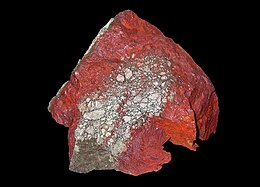
Back زنجفر Arabic Cinabriu AST Kinovar Azerbaijani Кінавар Byelorussian Цинобър Bulgarian Cinabarit BS Cinabri Catalan Cinabarit Czech Cinnober Danish Cinnabarit German
| Cinnabar | |
|---|---|
 | |
| General | |
| Category | Sulfide mineral |
| Formula (repeating unit) | Mercury(II) sulfide, HgS |
| IMA symbol | Cin[1] |
| Strunz classification | 2.CD.15a |
| Crystal system | Trigonal |
| Crystal class | Trapezohedral (32) (same H–M symbol) |
| Space group | P3121, P3221 |
| Unit cell | a = 4.145(2) Å, c = 9.496(2) Å, Z = 3 |
| Identification | |
| Color | Cochineal-red, towards brownish red and lead-gray |
| Crystal habit | Rhombohedral to tabular; granular to massive and as incrustations |
| Twinning | Simple contact twins, twin plane {0001} |
| Cleavage | Prismatic {1010}, perfect |
| Fracture | Uneven to subconchoidal |
| Tenacity | Slightly sectile |
| Mohs scale hardness | 2.0–2.5 |
| Luster | Adamantine to dull |
| Streak | Scarlet |
| Diaphaneity | Transparent in thin pieces |
| Specific gravity | 8.176 |
| Optical properties | Uniaxial (+); very high relief |
| Refractive index | nω = 2.905 nε = 3.256 |
| Birefringence | δ = 0.351 |
| Solubility | 1.04×10−25 g/100 ml water (Ksp at 25 °C = 2×10−32)[2] |
| References | [3][4][5][6] |
Cinnabar (/ˈsɪnəˌbɑːr/; from Ancient Greek κιννάβαρι (kinnábari)),[7] or cinnabarite (/ˌsɪnəˈbɑːraɪt/), also known as mercurblende is the bright scarlet to brick-red form of mercury(II) sulfide (HgS). It is the most common source ore for refining elemental mercury and is the historic source for the brilliant red or scarlet pigment termed vermilion and associated red mercury pigments.
Cinnabar generally occurs as a vein-filling mineral associated with volcanic activity and alkaline hot springs. The mineral resembles quartz in symmetry and it exhibits birefringence. Cinnabar has a mean refractive index near 3.2, a hardness between 2.0 and 2.5, and a specific gravity of approximately 8.1. The color and properties derive from a structure that is a hexagonal crystalline lattice belonging to the trigonal crystal system, crystals that sometimes exhibit twinning.
Cinnabar has been used for its color since antiquity in the Near East, including as a rouge-type cosmetic, in the New World since the Olmec culture, and in China since as early as the Yangshao culture, where it was used in coloring stoneware.
Associated modern precautions for the use and handling of cinnabar arise from the toxicity of the mercury component, which was recognized as early as ancient Rome.
- ^ Warr, L.N. (2021). "IMA–CNMNC approved mineral symbols". Mineralogical Magazine. 85 (3): 291–320. Bibcode:2021MinM...85..291W. doi:10.1180/mgm.2021.43. S2CID 235729616.
- ^ Myers, R. J. (1986). "The new low value for the second dissociation constant of H2S. Its history, its best value, and its impact on teaching sulfide equilibria". Journal of Chemical Education. 63: 689.
- ^ "Cinnabar". Mineralienatlas.
- ^ "Cinnabar (HgS)" (PDF). rruff.geo.arizona.edu. Retrieved 2015-07-24.
- ^ "Cinnabar: Cinnabar mineral information and data". Mindat. Retrieved 2015-07-24.
- ^ "Cinnabar Mineral Data". Webmineral. Retrieved 2015-07-24.
- ^ Chisholm, Hugh, ed. (1911). . Encyclopædia Britannica. Vol. 6 (11th ed.). Cambridge University Press. p. 376.
© MMXXIII Rich X Search. We shall prevail. All rights reserved. Rich X Search